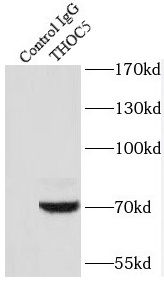Products
THOC5 antibody
| Synonyms: | THO complex subunit 5 homolog|Functional spliceosome-associated protein 79 (fSAP79)|NF2/meningioma region protein pK1.3|Placental protein 39.2 (PP39.2)|hTREX90|THOC5|C22orf19|KIAA0983 antibody | ||
| Catalogue No.: | FNab08668 | Reactivity: | Human, Mouse, Rat |
| Host: | Rabbit | Tested Application: | ELISA, IHC, WB, IF, IP |
| Clonality: | polyclonal | Isotype: | IgG |
| Size | Price |
|---|---|
| 100µg | Inquiry |
- SPECIFICATIONS
- FIGURES
- CONDITIONS
- FAQS
- Product Name
- THOC5 antibody
- Catalogue No.
- FNab08668
- Size
- 100μg
- Form
- liquid
- Purification
- Immunogen affinity purified
- Purity
- ≥95% as determined by SDS-PAGE
- Clonality
- polyclonal
- Isotype
- IgG
- Storage
- PBS with 0.02% sodium azide and 50% glycerol pH 7.3, -20℃ for 12 months(Avoid repeated freeze / thaw cycles.)
- Immunogen
- THO complex 5
- Alternative Names
- THO complex subunit 5 homolog|Functional spliceosome-associated protein 79 (fSAP79)|NF2/meningioma region protein pK1.3|Placental protein 39.2 (PP39.2)|hTREX90|THOC5|C22orf19|KIAA0983 antibody
- UniProt ID
- Q13769
- Observed MW
- 79 kDa
- Tested Applications
- ELISA, IHC, WB, IF, IP
- Recommended dilution
- WB: 1:500-1:2000; IHC: 1:20-1:200; IF: 1:20-1:200
 HEK-293 cells were subjected to SDS PAGE followed by western blot with FNab08668(THOC5 Antibody) at dilution of 1:600
HEK-293 cells were subjected to SDS PAGE followed by western blot with FNab08668(THOC5 Antibody) at dilution of 1:600
 IP Result of anti-THOC5 (IPFNab08668, 3ug; Detection:FNab08668 1:300) with HEK-293 cells lysate 2000ug.
IP Result of anti-THOC5 (IPFNab08668, 3ug; Detection:FNab08668 1:300) with HEK-293 cells lysate 2000ug.
 Immunohistochemistry of paraffin-embedded human breast cancer tissue slide using FNab08668(THOC5 Antibody) at dilution of 1:50
Immunohistochemistry of paraffin-embedded human breast cancer tissue slide using FNab08668(THOC5 Antibody) at dilution of 1:50
- Background
- Acts as component of the THO subcomplex of the TREX complex which is thought to couple mRNA transcription, processing and nuclear export, and which specifically associates with spliced mRNA and not with unspliced pre-mRNA. TREX is recruited to spliced mRNAs by a transcription-independent mechanism, binds to mRNA upstream of the exon-junction complex(EJC) and is recruited in a splicing-and cap-dependent manner to a region near the 5' end of the mRNA where it functions in mRNA export to the cytoplasm via the TAP/NFX1 pathway. The TREX complex is essential for the export of Kaposi's sarcoma-associated herpesvirus(KSHV) intronless mRNAs and infectious virus production. THOC5 in conjunction with ALYREF/THOC4 functions in NXF1-NXT1 mediated nuclear export of HSP70 mRNA; both proteins enhance the RNA binding activity of NXF1 and are required for NXF1 localization to the nuclear rim. Involved in transcription elongation and genome stability. Involved in alternative polyadenylation site choice by recruiting CPSF6 to 5' region of target genes; probably mediates association of the TREX and CFIm complexes.Regulates the expression of myeloid transcription factors CEBPA, CEBPB and GAB2 by enhancing the levels of phosphatidylinositol 3,4,5-trisphosphate. May be involved in the differentiation of granulocytes and adipocytes. Essential for hematopoietic primitive cell survival and plays an integral role in monocytic development.
How many times can antibodies be recycled?
First, usually it's not suggested to recycle antibodies. After use, buffer system of antibodies has changed. The storage condition of recycled antibodies for different customers also varies. Thus, the performance efficiency of recycled antibodies can’t be guaranteed. Besides, FineTest ever conducted the antibody recycling assay. Assay results show recycling times of different antibodies also varies. Usually, higher antibody titer allows more repeated use. Customers can determine based on experimental requirements.
Notes: After incubation, we recycle rest antibodies to centrifuge tube and store at 4℃. High titer antibodies can be stored for a minimum of one week. Reuse about three times.
What are components of FineTest antibody buffer?
Components of FineTest antibody buffer are usually PBS with proclin300 or sodium azide, BSA, 50% glycerol. Common preservative is proclin300 or sodium azide, which is widely applied in the lab and industry.
How about the storage temperature and duration of FineTest antibodies?
Most antibodies are stored at -20℃. Directly-labeled flow cytometry antibodies should be stored at 2 - 8℃. The shelf life is one year. If after sales issues for purchased antibodies appear, return or replacement is available. Usually, antibodies can be still used after the one-year warranty. We can offer technical support services.
Is dilution required for FineTest antibodies? What’s the dilute solution?
Directly-labeled flow cytometry antibodies are ready-to-use without dilution. Other antibodies are usually concentrated. Follow the dilution ratio suggested in the manual. Dilute solution for different experiments also varies. Common antibody dilution buffers are acceptable(e.g. PBST, TBST, antibody blocking buffer).
How to retrieve antibodies for immunohistochemistry?
Common retrieval buffers: Tris-EDTA Buffer(pH 9.0); Citrate Buffer(pH 6.0)
Heat induced antibody retrieval:
Method 1: Water-bath heating: Put the beaker with retrieval buffer and slide in the boiling water bath. Keep the boiling state for 15min. Naturally cool to room temperature;
Method 2: Microwave retrieval: Put the beaker with retrieval buffer and slide in the microwave oven. Heat at high power for 5min, Switch OFF for 3min, Heat at medium power for 5min. Naturally cool to room temperature.
How to choose secondary antibodies?
(1) Secondary antibodies react with primary antibodies. Thus, secondary antibodies should be against host species of primary antibodies. E.g. If the primary antibody is derived from rabbit, the relevant secondary antibody should be against rabbit. E.g. goat anti rabbit or donkey anti rabbit.
(2) Choose secondary antibody conjugates according to the experimental type, e.g. ELISA, WB, IHC etc. Common enzyme conjugated secondary antibodies are labelled by HRP, AP etc. Fluorescin or dye labelled secondary antibodies are applied in immunofluorescence and flow cytometry(e.g. FITC, Cy3).
